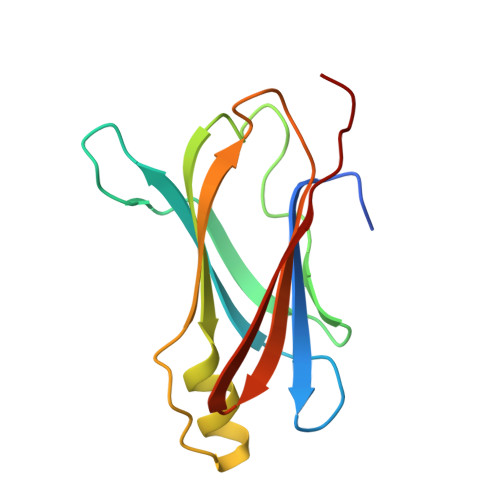Structures of human transthyretin complexed with thyroxine at 2.0 A resolution and 3',5'-dinitro-N-acetyl-L-thyronine at 2.2 A resolution.
Wojtczak, A., Cody, V., Luft, J.R., Pangborn, W.(1996) Acta Crystallogr D Biol Crystallogr 52: 758-765
- PubMed: 15299640
- DOI: https://doi.org/10.1107/S0907444996003046
- Primary Citation of Related Structures:
2ROX, 2ROY - PubMed Abstract:
The molecular structures of two human transthyretin (hTTR, prealbumin) complexes, co-crystallized with thyroxine (3,5,3',5'-tetraiodo-L-thyronine; T(4)), and with 3',5'-dinitro-N-acetyl-LL-thyronine (DNNAT), were determined by X-ray diffraction methods. Crystals of both structures are orthorhombic, space group P2(1)2(1)2, and have two independent monomers in the asymmetric unit of the crystal lattice. These structures have been refined to 17.0% for 8-2.0 A resolution data for the T(4) complex (I), and to R = 18.4% for 8-2.2 A resolution data for the DNNAT structure (II). This report provides a detailed description of T(4) binding to wild-type hTTR at 2.0 A resolution, as well as DNNAT. In both structures, the two independent hormone-binding sites of the TTR tetramer are occupied by ligand. A 50% statistical disorder model was applied to account for the crystallographic twofold symmetry along the binding channel and the lack of such symmetry for the ligands. Results for the co-crystallized T(4) complex show that T(4) binds deep in the hormone-binding channel and displaces the bound water previously reported for T(4) soaked into a native transthyretin crystal [Blake & Oatley (1977). Nature (London), 268, 115-120]. DNNAT also binds deeper in the channel toward the tetramer center than T(4) with the nitro groups occupying the symmetrical innermost halogen pockets. The N-acetyl moiety does not form polar contacts with the protein side chains as it is oriented toward the center of the channel. The weak binding affinity of DNNAT results from the loss of hydrophobic interactions with the halogen binding pockets as observed in T(4) binding. These data suggest that the halogen-binding sites toward the tetramer center are of primary importance as they are occupied by analogues with weak affinity to TTR, and are therefore selected over the other halogen sites which contribute more strongly to the overall binding affinity.
- Hauptman-Woodward Medical Research Institute, Inc., Buffalo, NY 14203, USA.
Organizational Affiliation:

















